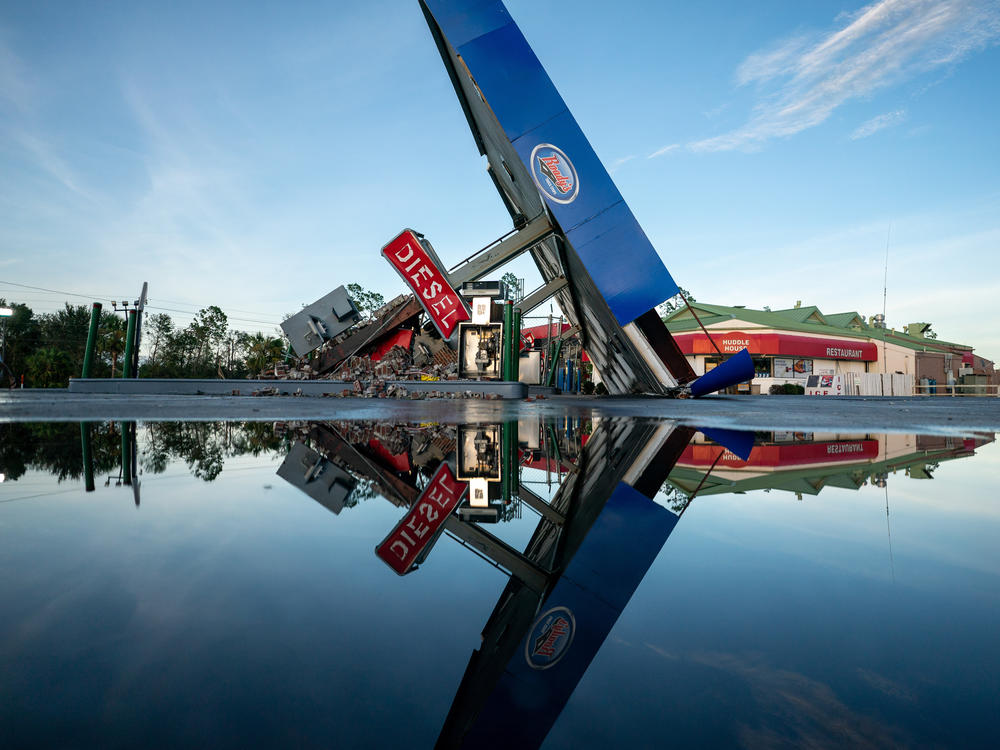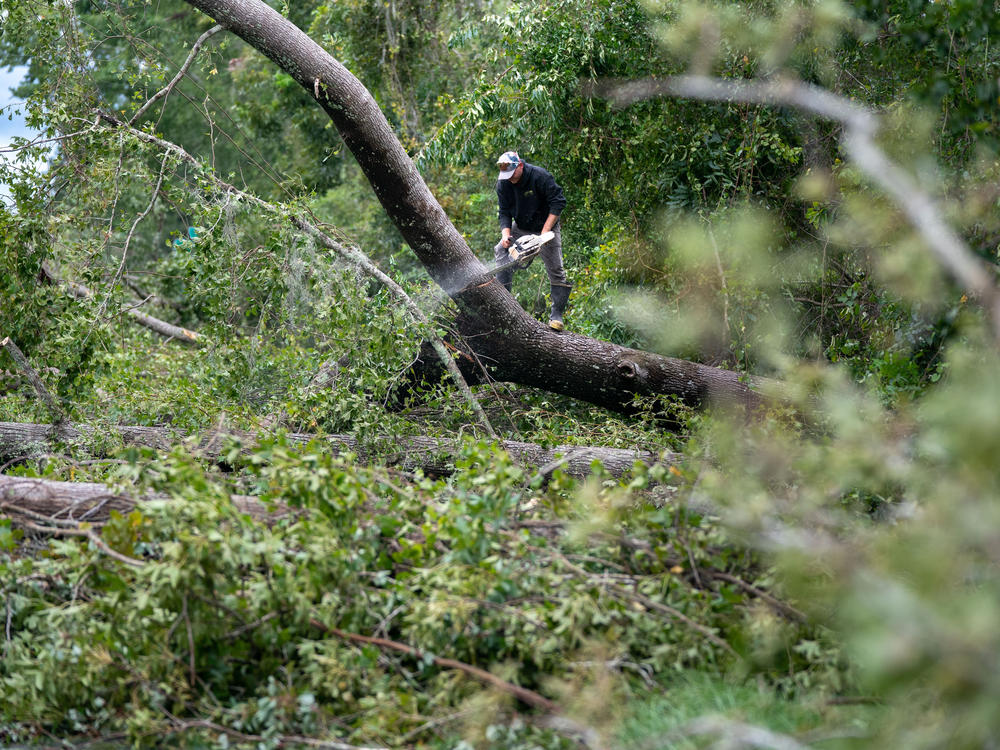Section Branding
Header Content
Hurricane Idalia's aftermath: Florida rushes to restore power and clear debris
Primary Content
Updated August 31, 2023 at 1:46 PM ET
Across the Southeast, hundreds of thousands are without power, roads are littered with storm debris and fears over the possibility of severe flooding remain as Idalia, now a tropical storm, heads out to sea again.
The storm made landfall on Florida's Gulf Coast as a Category 3 hurricane on Wednesday morning, submerging neighborhoods and leaving a trail of debris as it thrashed its way east across Georgia.
What's the latest with today's forecast?
The center of the storm has moved off the North Carolina coast and out over the Atlantic Ocean, but strong winds and coastal storm surge are likely to continue to impact the Carolinas throughout the day, according to an 11:00 a.m. ET advisory from the National Hurricane Center.
Forecasters described the risk of storm surge as potentially "life-threatening."
A supermoon that peaked Wednesday night is expected to exacerbate the range of coastal tides, bringing an added layer of danger. Residents of the Carolinas have also been warned of the risk for tornadoes.
North and South Carolina remain under an emergency declaration as of mid-day Thursday.
"We're hoping for the best and preparing for the worst," North Carolina Gov. Roy Cooper said on Wednesday. "We expect winds, rain and flooding to continue to impact our state even into Saturday."
The storm's strength is expected to remain consistent throughout the day, possibly even strengthening slightly into a post-tropical cyclone, before tapering off over the weekend, as it approaches Bermuda. Maximum sustained wind speeds of near 60 mph extend outward from the center of the storm for up to 205 miles, the NHC said.
What kind of damage has Idalia caused so far?
The storm made landfall near Keaton Beach, Fla. at about 7:45 a.m. as a Category 3 hurricane with 125 mph winds — tied as the strongest to hit the Big Bend region of the state.
Idalia remained a hurricane as it tore into Georgia with winds at 90 mph, then slowed to a tropical storm as it crossed into South Carolina.
Across the region, heavy rains left entire neighborhoods submerged. Strong winds tore storefronts from their foundations, peeled back the roofs of hundreds of houses and sent power lines swinging.
Despite mandatory evacuation orders, boat teams in Florida rescued more than 75 people in St. Petersburg and another 60 people from Hudson from several feet of storm surge.
A gauge along Big Bend's Steinhatchee River measured an increase from from 1 foot to 8 feet in just an hour, enough to reverse the flow of the river; sailboats, loosed from their moorings, were seen crashing against a traffic bridge.
In the town of Perry, Fla., on Thursday, a single-engine airplane still sat upside down on the municipal tarmac, and the steel canopy of a gas station lay sideways in a pool of storm water.
"Nobody died, that's the key," Tallahassee resident Doug Everett, one of the owners of Ware Oil and Supply Co., told The News Service of Florida outside the station.
"Most everybody here, company-wise, evacuated. As a matter of fact, my county manager was just rolling back into town from evacuation. They don't know what their house looks like, they haven't been there yet," he added.
All along the Big Bend region, survivors are emerging to take stock of their losses.
"I don't ever want to go through that again," one Florida resident, Ron Elrod, told WSUF public media, an NPR member station. "When you see the walls on the building that you're in move, it makes you wonder whether you made the right decision to evacuate. But I'm glad we left."
Elrod and his family of four, plus two cats and a dog named Buddy, waited out the storm from inside a friend's garage in Perry, after leaving behind their trailer in the hard-hit town of Steinhatchee. The family and the trailer were still intact on Thursday.
"A lot of our people in Steinhatchee weren't as lucky as us. Some told me they saw houses floated out of the river mouth," he said.
In South Carolina, the National Weather Service reported "major coastal inundation," including in downtown Charleston where water had broken through the historic seawall, the Charleston battery.
On Thursday, President Biden signed a major disaster declaration at the request of Florida Gov. Ron DeSantis, which frees up financial assistance for both individuals impacted by the storm and public infrastructure.
How long will it take to fix the power outages?
More than 210,000 homes and businesses were still without power across Florida, Georgia and the Carolinas as of Thursday afternoon , according to the monitoring site PowerOutage.us, and broken traffic signals throughout the region are adding another layer of danger to travel conditions.
DeSantis said more than 420,000 customers have had their power restored since the storm hit. Unlike in past hurricanes, the bulk of these outages are in very rural counties where the power distribution comes from small electric co-ops rather than large utilities.
DeSantis said that tens of thousands of linemen were at work trying to restore power in his state alone.
Unlike past disasters, there may be one or two homes along a five or 10 mile stretch of road – so it could take days or longer to re-string lines across these large distances to connect a handful of customers. It's unclear if power substations were heavily damaged – which would take longer to rebuild.
Kevin Guthrie, the director of Florida's Division of Emergency Management, says the vast majority of customers should have power restored in 48 hours.
What's happening with search and rescue efforts?
Despite the damage, only a handful of deaths have been linked to the hurricane, a sizable contrast to Hurricane Ian, which claimed 149 lives when it pounded Florida last year.
At least one person was killed in Georgia when a tree fell on a vehicle, the state's emergency chief, James Stallings, said in a briefing Thursday.
Meanwhile, Florida Highway Patrol officials said two men were killed in separate rain-related crashes hours before Idalia struck the state.
Gov. DeSantis said Florida officials were vetting "one unconfirmed fatality" as a possible storm-related death, but he didn't say whether it was one of the two Florida deaths reported earlier in the day.
The path of the storm may have helped spare the state some damage. Idalia avoided heavily populated areas as it made landfall in the Big Bend region, a sprawling agricultural region where Florida's panhandle merges with the peninsula.
It appears that most people in impacted areas did heed warnings to evacuate, Gov. DeSantis said at a press briefing on Wednesday. He said search and rescue teams had visited "about 70%" of the areas they needed to check.
As of Wednesday evening, there were no outstanding missing person reports, said Guthrie of the Florida Division of Emergency Management.
This reporting originally appeared in NPR's digital live coverage. NPR's Bobby Allyn, Vanessa Romo, Ayana Archie, Russell Lewis and Rachel Treisman contributed reporting.
Copyright 2023 NPR. To see more, visit https://www.npr.org.


